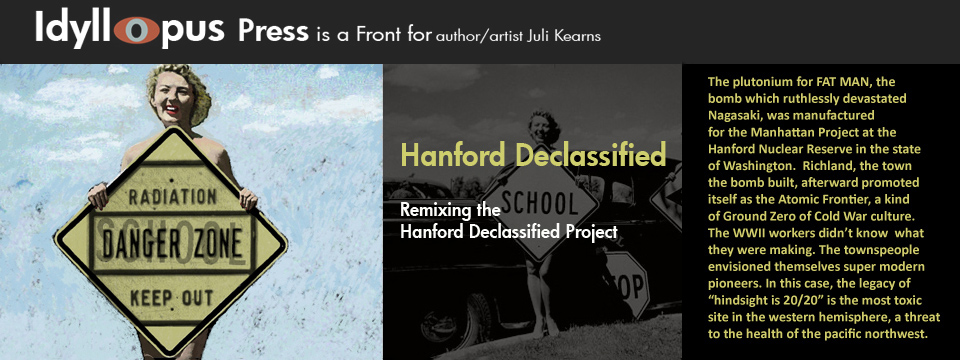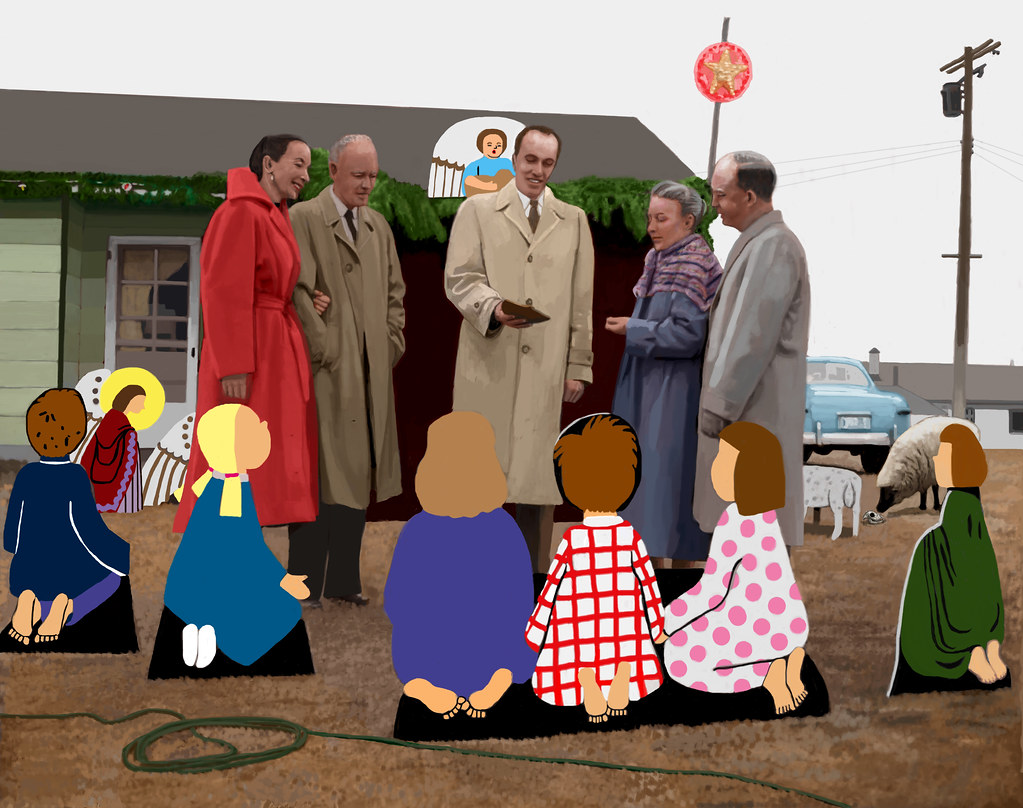Prize for Christmas Decorations, Declassified
2005
20 w by 16 in h
Digital Painting
Based on a photo from the "Hanford Historical Photo Declassification Project".
© copyright Jk
Read the introduction to the Remixing the Hanford Declassified Project paintings
Everybody has won and all must have prizes
I know those houses. I grew up in houses just like that, playing on lawns just like that. My Christmases looked just like that--well, except for the decorations. We didn't decorate. But others did, and I see the star on the pole and my heart goes pitter-patter because I know those decorations.
Working on this picture took a couple of weeks off and on and while I worked I was reminded me of what the terrain was like in Richland during the winter, the desert and the rough yards on the desert border. I was reminded me of the earth and dead desert foliage and grass, up close in the way a child is up close to it, playing on the ground, recollected the way it was cold, and the cold light of the shortened day in which all colors washed together.
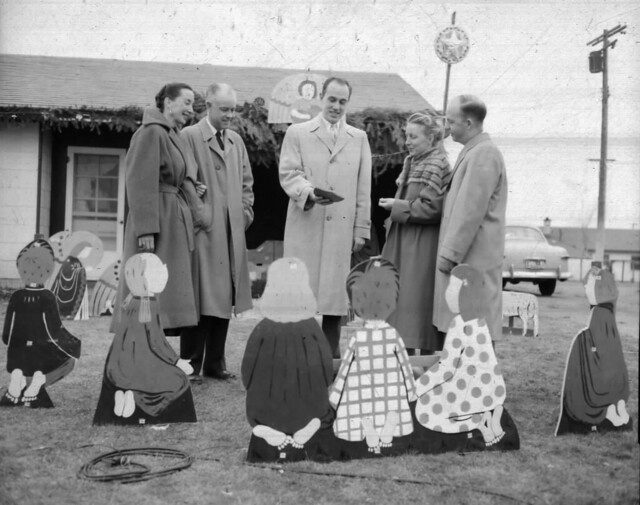
DDRS Record Details for Record Accession Number
"N1D0043600"
Accession Number N1D0043600
Document Number 12597-1-NEG-C
Alternate Document Number 12597-1-NEG
Title Description WINNERS OF CHRISTMAS DECORATION CONTEST - MR. AND MRS. H.C. LEE, MR. AND MRS. R.E. FIELD
Key Word(s) CHRISTMAS DECORATION CONTEST,MR AND MRS HC LEE,MR AND MRS RE FIELD
Document Date 20-Dec-1954
Public Availability Date 14-Feb-2002
There are a number of photos for prizes awarded to be found in the Hanford Declassified database. Dance prizes. Prizes for suggestions for work improvements at Hanford. Prizes at the Atomic Frontier Days celebrations. Prizes awarded at the parks for children in doll and other competitions.
When I was ten, my mother dressed me up one day and ordered me to get over to the Junior High for a a doll competition I'd no idea was going on and at which I felt completely absurd, dressed up in Sunday best, carrying a doll she'd purchased me for my birthday. It was a pretty doll. Actually, it was a beautiful doll. The doll looked very natural with a lovely face and soft body and limbs and head formed of a plastic that was pleasing soft to the touch. It looked and just like my sister.
But dolls weren't my thing. I hadn't been interested in baby dolls since I was very little, and I was certainly not interested in a doll competition.
As it turned out, my doll was awarded first place. I was given a ribbon. A picture was taken.
All I'd had to do was show up.
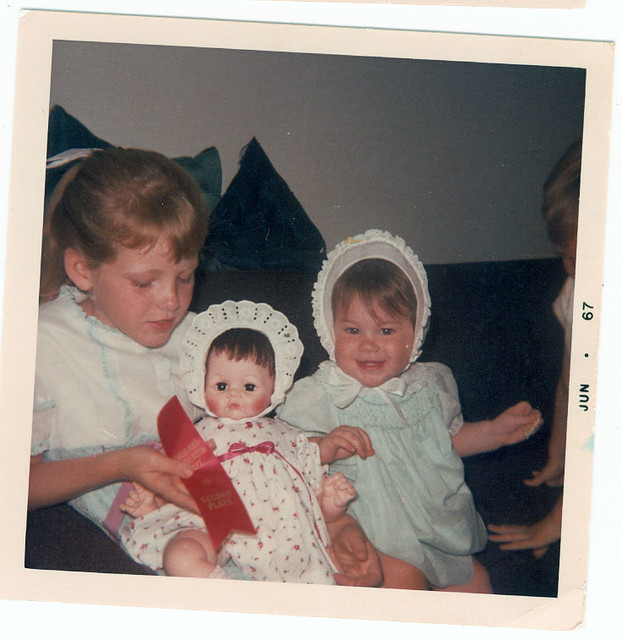
I felt false and lousy for winning when there was no talent involved. I hung my head in shame around those with handmade dolls. But a photo in the Hanford Declassified database from 1951 reveals that this is possibly what the doll show was about, who made the best purchase of a doll, at least according to the judges. If there are any girls here hanging there heads in shame, they hide it well.
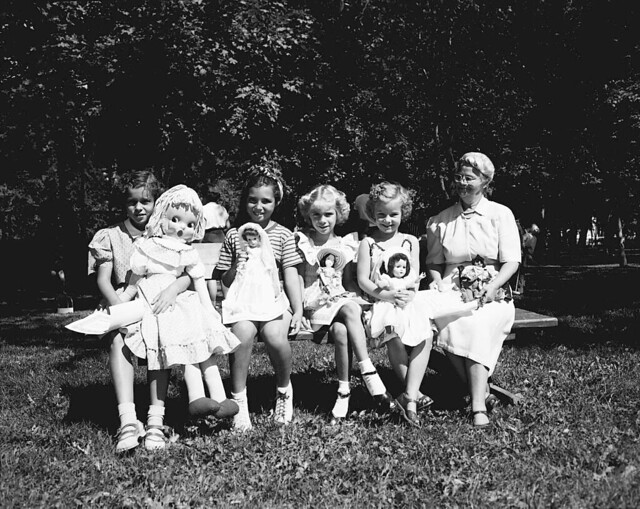
DDRS Record Details for Record Accession Number
"N1D0035782"
Accession Number N1D0035782
Document Number 2157-1-NEG-I
Alternate Document Number 2157-1-NEG
Title Description DOLL SHOW WINNERS -- TABLE TENNIS JUNIOR DIVISION WINNER - 12 YEAR OLD DENNIS SMITH - RIVERSIDE PARK
Document Date 25-Jul-1951
Public Availability Date 14-Feb-2002
Richland gave so many opportunities for you to be a winner, because it wanted you to know that as a citizen of the town that built Fat Man, you were already a winner for life
Richland was fond of competitions and awarding prizes. It occurred to me, looking through the database, that the competitions and awarding of prizes perhaps had a lot to do with efforts to build community and good will in this government-built town populated with people who didn't have natural bonds of hometown and family, who instead held in common their work. To establish a sense of belonging, emotional ties, of place and recognition tied up with the ribbon (or plaque or coffeepot or grill).
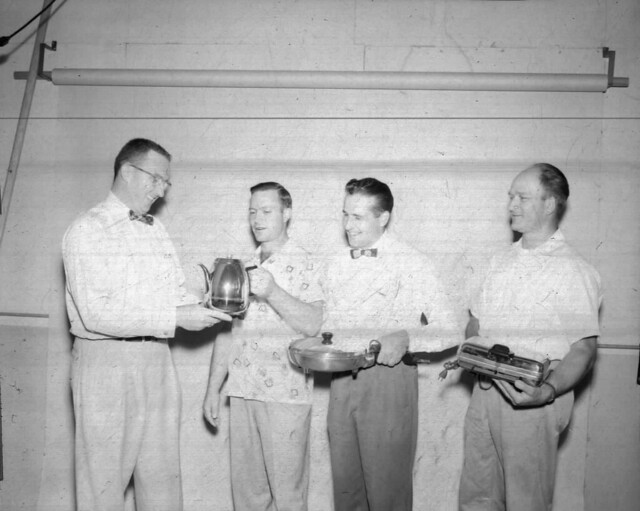
DDRS Record Details for Record Accession Number
"N1D0019725"
Accession Number N1D0019725
Document Number 14415-NEG-B
Alternate Document Number 14415-NEG
Title Description THREE SLOGAN WINNERS AND THEIR PRIZES
Key Word(s) HANFORD SITE
Document Date 02-Sep-1955
Public Availability Date 14-Feb-2002
There are pictures of people receiving their prizes. There are pictures of only the prizes, laid out on tables. There are pictures of prizes for dances that look like a display of goods for a game show.

DDRS Record Details for Record Accession Number
"N1D0020954"
Accession Number N1D0020954
Document Number 14721-NEG-C
Alternate Document Number 14721-NEG
Title Description PRIZES FOR DANCE
Key Word(s) HANFORD SITE
Document Date 30-Jul-1956
Public Availability Date 14-Feb-2002

DDRS Record Details for Record Accession Number
"N1D0020953"
Accession Number N1D0020953
Document Number 14721-NEG-B
Alternate Document Number 14721-NEG
Title Description PRIZES FOR DANCE
Key Word(s) HANFORD SITE
Document Date 30-Jul-1956
Public Availability Date 14-Feb-2002

DDRS Record Details for Record Accession Number
"N1D0044583"
Accession Number N1D0044583
Document Number 12949-NEG-C
Alternate Document Number 12949-NEG
Title Description DOOR PRIZES FOR SUPERVISORS DANCE
Key Word(s) DOOR PRIZES,HANFORD SITE,SUPERVISORS DANCE
Document Date 03-Jun-1955
Public Availability Date 14-Feb-2002
There were even polka dot contests. In 1949, 1/6th of the population of Richland was under the age of 6. Here, apparently, children were being judged on who made the best polka dot bowtie.
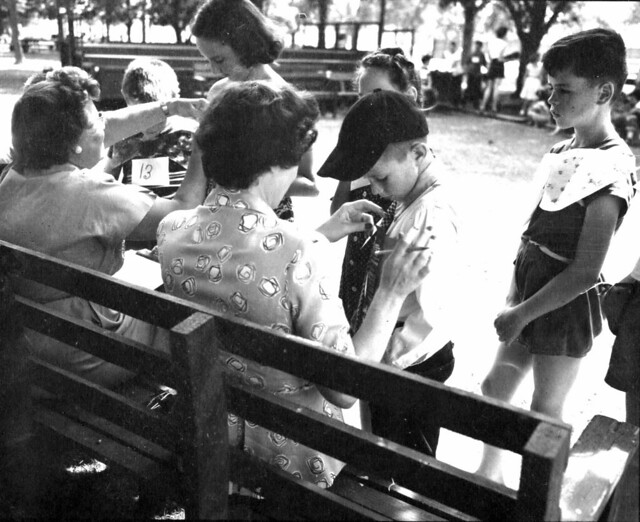
DDRS Record Details for Record Accession Number
"N1D0053337"
Accession Number N1D0053337
Document Number 1185-50-NEG-G
Alternate Document Number 1185-50-NEG
Title Description POLKA DOT CONTEST - CHILDREN IN RIVERSIDE PARK
Key Word(s) CHILDREN CONTEST,RECREATIONAL,RICHLAND PARK
Document Date 05-Feb-2002
Public Availability Date 14-Jun-2002
Richland gave you every opportunity to win at something.
So, rather than the picture for best Christmas decorations of 1954 being simply a document of an award for best Christmas yard decorations, one could interpret it instead as, "Here's another award intended to build community ties and help make you happy campers devoted to the plutonium cause."
With all those prizes, Hanford was also making up for the little sibling identity crisis because it had made the plutonium that rained hell on Nagasaki, and all anyone could talk about was Hiroshima, Hiroshima, Hiroshima
Alain Resnais even made a movie about it. Hiroshima Mon Amour. He didn't make a film about Nagasaki, because Nagasaki came in second place.
That the plutonium dropped on Nagasaki was made at Hanford, or that Hanford is said by some to be the most polluted site in the western hemisphere, and one of the most polluted sites in the world, is still, I don't believe, known by a lot of people.
[NOTE: The following statistics are from 2006 and current searches will of course reveal different numbers.]
And I don't think many would much care. Out of sight, out of mind for the majority. The government will take care of it for us. Hanford, for whatever reason, just doesn't seem to be that sexy a cause. When I do a search on Google for "blog, hanford, plutonium" there are only 893 results, most of them news or news-oriented sites. Idyllopus comes up in the number 8 and 15 slots. There's not a whole hell of a lot being written on it out in the blogosphere. And I don't believe anyone has ever visited this blog googling for information on Hanford. Which is fine, I'm not a resource for information and don't intend to be. I'm just saying it's not as great a concern in the public imagination as it should be. Google "blog, ann coulter" and there are 1,830,000 results. Google "blog, Simpons" and there are 2,740,000 results. Homer works in a nuclear reactor. But Google, "blog, hanford, downwinders" and you get 193 results. Google "blog, hanford, radioactive iodine" and you get 186 results. Google "blog, Paris Hilton" and the results are 3,500,000.
Google "blog, Nagasaki" and the results are 415,000. Hiroshima is over three times as popular at 1,500,000 results.
Odd that if you google "blog, Chernobyl" the results are 374,000 while if you google "blog, hanford" the results are 301,000, and many of those returns will have nothing to do with Hanford, the nuclear reserve. No, add in nuclear and the results go down to 30,600. A lot better than the results for "blog, hanford, plutonium" but nowhere near the status of Chernobyl or Ann Coulter, the Simpsons, Britney Spears, Sex Pistols, Mount Rushmore or even the "War against Christmas" which rates 51,500 results.
But recent budget cuts for Hanford clean-up, signed by Bush at around Thanksgiving, seems to me, should be bigger news on both sides of the aisle than candy canes.
Like I said, Hanford and its toxic wastes and what it meant to the people of the area and to Nagasaki and the threat hanging over the Columbia River just aren't sexy subjects apparently and not particularly humorous either.
Unless you consider the alligators that escaped the Hanford farm at one point and got into the Columbia River.
As for me, I'm just taking pictures that were recently declassified, after 40 to 50 years of government black-out, and providing a second look at them after the first cursory glance. I don't think many people are going to search through the Declassification Project archive for pics and I doubt they are going to pay much attention to the lives of the people at Hanford and Richland as they are represented in the archive. After four and five decades as classified information, the recently released images will be thought of as irrelevant and the images of beauty queens and prize winners purely extraneous.
Which I don't believe them to be. They provide important information on the life of a community which was formed for the purpose of building The Bomb, a community and place still exploring and suffering the consequences. For which reason I take the images and make digital paintings based on them, adding a touch of subcontext. Such as references to Nagasaki in some.
No prizes for living in the downwind Death Mile
People raised sheep in the Hanford area before the arrival of plutonium. And during. And after. I had a little Wirehaired Fox Terrier, ill suited to yard life and children, that was given to a person across the river who had sheep and when we visited they said she was a fine dog for helping with the sheep.
Tom Bailey: Well, growing up here downwind from Hanford never meant anything to us because it was just a neighbor. Our business was to grow food and their business was to make nuclear weapons. And we never paid any attention to what they did. We never looked over the fence. But we always had deformed farm animals. The largest amount of farm animals at one time was 80 calves out of 200 cows that were grossly deformed. Either they died or they were too deformed to walk. We had deformed sheep, deformed kittens, deformed chickens. In some years, there were a lot of them, and in other years there weren't so many.
Narrator: In the mid-1980s, Tom Bailey began to wonder: If the animals on the farms were so affected, what about the people? He himself was born with birth defects, and today is sterile. He surveyed the 28 families who lived in a small area near Hanford, and found that 27 of them had suffered severe health problems, all of which are associated with exposure to high doses of radiation. This area is now know as "the death mile."
Tom Bailey: This is the north corner of it here, beginning with the Weinberger household. The 1973 March of Dimes poster child was born there with no eyes. The family back in behind here, the boy and his wife just had a child born with no skull.
Narrator: June Casey and the residents of "death mile" are not alone. Thousands of people who lived in the northwestern United States have experienced similar devastating health problems. As the medical histories of Hanford "downwinders" began to come to light, the government was forced to begin revealing some of the classified documents about what had really been going on at Hanford.
A picture has begun to emerge of enormous radioactive releases - some accidental, and many intentional - into the air, the ground, and the Columbia River which runs right through the Hanford complex. Enormous radioactive releases that G.E. knew about at the time, but chose to cover up.
Tom Bailey: We took, here in Eastern Washington State, the downwind area, twice the amount of radiation as the children at Chernobyl took. And at Chernobyl, they impounded all the milk, they evacuated whole towns, they cordoned off hundreds of miles of farmland. They [the Soviets] evacuated their people, and they warned them. And here, there was absolutely no warning. They didn't evacuate anybody. Quite to the contrary, they came and said, "You're safe."
Source: Deadly Deception: General Electric, Nuclear Weapons, and our Environment
In my digital paining, the sheep cut-out is nosing a skull that I added.
I added it for the Death Mile.
No prizes for the clean-up
I read that Bush has plans to cut millions of dollars in funding for Hanford's clean-up, the excuse being it is instead needed for Katrina.
Murray Resets Focus on Future for vit Project Published Thursday, December 8th, 2005
By Annette Cary, Herald staff writer
After four months of wrangling with the Department of Energy for money for Hanford's vitrification plant in fiscal year 2006, U.S. Sen. Patty Murray has moved on to fighting for money for fiscal 2007.
She met Wednesday with contractor and DOE officials on the project in Richland, just two days after Bechtel National announced 515 people would lose their jobs because funding has dropped to $526 million for 2006.
But she offered some encouragement for 2007.
DOE has a stronger commitment to the project now than it did during the 2006 budget process, she believes, based on her conversations with Energy Secretary Samuel Bodman.
"At this point, I take him at his word," she said.
DOE also remains committed to finishing the plant, she said.
She's seeking at least $690 million for 2007, she said. More would help complete it sooner, and less would add to long-term costs, she said.
DOE started building the massive plant with a plan to allocate $690 million for construction for each of five years, including 2006 and 2007. It is legally required to begin operating in 2011 to turn some of Hanford's worst radioactive waste into glass logs for permanent disposal.
But technical and other problems have slowed construction, and the plant is not expected to open until possibly four years past the legal deadline.
DOE did not ask for enough money for 2006, then didn't fight for it when Congress considered further cuts, Murray said.
"I want to make sure ... this is not another year of poor communication and misunderstanding of the importance of the plant," she said.
A report DOE expects to finish in June on the plant cost and schedule is critical, and DOE needs to be open about information in it, she said.
On Tuesday, DOE released a less complete seven-month-old report about the cost and schedule. It had been kept secret from the state congressional delegation and state leaders, despite their requests.
Congress still must address a White House proposal calling for another $100 million cut in funding for the plant to help with hurricane relief in the Gulf region.
Senate committee staffers have said the proposal, which includes $2.3 billion to be rescinded from federal programs, is unacceptable, Murray's staff said. The issue should be resolved within a few weeks, Murray said.
Wednesday's meeting with officials of Bechtel National and DOE's Hanford Office of River Protection covered the resolution of technical issues at the plant. Engineers and scientists have been working on problems such as design standards for earthquakes, potential hydrogen buildup in piping and keeping difficult radioactive liquids well mixed in areas too radioactive to allow human access to repair equipment.
It's no surprise there are technical issues on a project of such magnitude, Murray said.
The loss of workers, totaling about 1,700 during the past year with the latest layoffs, will limit how much progress can be made, she said.
"On a personal level, 500 people right before Christmas with no paycheck, my heart goes out," she said.
"The Department of Energy, Richland Operations Office (RL) has aggressively implemented the commitments made by the Federal Government to openness in Government which was stated as a 'Fundamental principle that an informed citizenry is essential to the democratic process and that the more the American people know about their Government, the better they will be governed. Openness in government is essential to accountability . . .' RL is committed to responsible openness. The Hanford Declassification Project (HDP) was initiated by RL to declassify to the maximum possible extent all previously classified Hanford operations information (documents and photographs). There are over 77,000 declassified photographs of early Hanford (1943 - 1960) available... \These World War II and Cold War era photographs depict early Hanford construction and the employees/families who lived and build/operated the site."
The plutonium for the bomb dropped on Nagasaki was manufactured at Hanford.
Originally published on my blog in December 18 of 2005.
